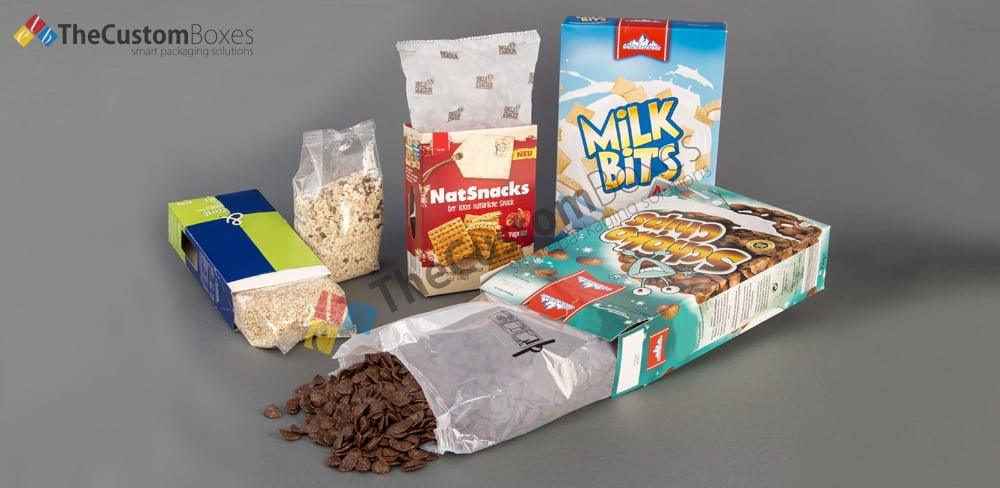Beyond communicating taste and nutritional information, cereal packaging has a big impact on customer behavior and marketing. Custom cereal box design, visual signals, and branding offer marketers psychological insights into their target audience. Printed cereal packaging influences customers at the critical moment of buying by not just standing out on store shelves but also evoking feelings of enjoyment, nostalgia, or health consciousness. The psychological impact includes the establishment of favorable associations via colors and visuals, the promotion of brand loyalty, and the communication of attributes such as originality or dependability through package components like fonts. In a competitive market, knowing these details enables marketers to carefully create boxes of cereal that appeal to consumers, influencing their tastes and encouraging purchases.
Visual Appeal and Brand Recognition:
Cereal boxes’ visual appeal is the first point of contact between the consumer and the product; bright colors, eye-catching designs, and designed logos all contribute to the development of brand recognition. Businesses spend a lot of money making sure their packaging looks good because they want customers to notice their items when they’re piled high on store shelves. Research shows that cereals usually attract customers with visually appealing packaging, indicating a tendency to choose products on appearance even when they are unfamiliar with the brand. This emphasizes how important initial impressions are in determining customer preferences and driving buying behavior.
Perceived Healthiness:
Using certain visual cues that consumers connect with healthiness, boxes of cereal often have text and images that promote nutritional values, health advantages, and ingredient quality. Earthy colors, fruit imagery, and terms like “whole grain”‘ create the impression of a product that is higher in nutrients. Aware of these connections, cereal producers craft their packaging to appeal to health-conscious consumers. They sway consumer decisions by employing these visual cues, since people like the cereals that support their views on wellness and health, which in turn influences their decisions to buy.
Packaging Size and Portion Control:
Cereal box sizes have a significant impact on what consumers choose, especially when it comes to portion control. Bigger family-sized boxes of cereal appeal to people looking to save money, while single-serving, smaller packets serve others who are more concerned with convenience and calorie intake. Recognizing that consumers have different needs, cereal makers offer a variety of container sizes to suit different tastes. This strategy sways consumers’ decisions by fitting in with their consumption patterns and way of life, enabling them to select the packaging size that most matches their priorities and unique requirements.
Innovative Shapes and Designs:
In the cutthroat world of consumer products, distinctive and creative printed cereal packaging designs are essential to building a strong and enduring brand identification. To engage consumers, boxes of cereal in particular are embracing innovative forms and including interactive features like games or QR codes. These components improve the customer experience by doing more than holding the goods; they also build favorable associations with the brand and leave a lasting impression. By adding these characteristics, the product not only stands out on store shelves but also can affect future purchases because customers will encourage the packaging’s unique and interesting qualities.
Environmental Considerations:
As consumers’ knowledge of the environment grows, cereal makers are modifying their packaging techniques to better meet sustainability objectives. On their wholesale cereal boxes, several are displaying eco-friendly practices and using recyclable materials. This change reflects a changing consumer mindset in which cereal packaging’s perceived eco-friendliness influences purchases in a real way. Cereal businesses understand that to appeal to environmentally concerned consumers, they must not only offer a healthy product but also show a dedication to ethical and eco-sensitive packaging techniques. This is because consumers are placing a higher value on sustainability.
Messaging and Storytelling:
Boxes of cereal usually incorporate narrative features or messaging into their packaging, which tell stories about the brand’s origins, the sourcing of ingredients, or the vision and values of the firm. This deliberate use of storytelling seeks to build a strong bond between the brand and its audience by utilizing authenticity and emotional appeal to sway customer decisions. Cereal businesses that tell a captivating story to their customers not only educate them about their product but also help them feel a sense of shared values. This deeper connection with the brand can have a significant impact on the decisions that consumers make at the point of buying.
Promotions and Incentives:
Cereal producers use packaging to highlight promotions, discounts, and special offers like “buy one, get one free” and other incentives. Through the use of appealing labels that highlight these offers, cereal producers draw in consumers who are price-concerned and persuade them to choose one brand over another. The perceived value and possible savings conveyed through such promotions have a significant impact on decision-making at the point of buy. The brand’s competitive advantage in the market depends on its strong appeal to cost-conscious consumers through the emphasis on promotional packaging.
Age-Targeted Packaging:
Cereal companies often design their packaging with certain age groups in mind. For example, they may use vibrant, colorful designs with well-known characters or activities to appeal to younger consumers, while older consumers prefer more somber and elegant packaging. This focused approach to packaging design shows a sophisticated awareness of the various interests and preferences of various age groups. Cereal producers try to create a visual appeal that appeals to the target market and influences consumers’ decisions to buy by designing their packaging according to target demographics. This approach recognizes the value of visual communication in drawing in customers of all ages and swaying their preferences in a crowded market.
Final Thoughts:
Custom cereal box design, psychology, and marketing methods interact in a complex way to influence consumer choices. Cereal packaging influences customer decisions, influencing anything from portion control and environmental concerns to aesthetic appeal and health perceptions. Comprehending these subtleties is essential for cereal producers looking to gain market share as well as customers hoping to make wise and fulfilling decisions at breakfast. The potency of the box of cereal as a marketing tool is still an intriguing part of the customer experience, even as the aisle of cereal continues to change. The Custom Boxes offers the most affordable and sustainable printed cereal packaging and wholesale cereal boxes with free shipping all around the world.

